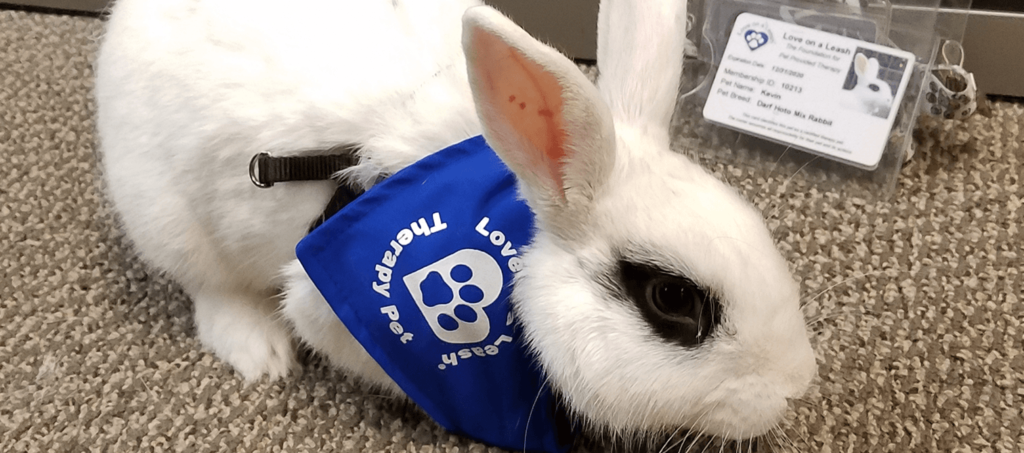Therapy cats & rabbits
Cats & rabbits can make wonderful therapy pets, too.
The therapy cat
“When I began doing therapy dog work, one resident kept asking me to bring in a cat. She said, ‘These dogs are okay but I’ve always had cats and I miss my cat. Can’t you bring in a cat?’ So, I taught Flea, who was ten years old at the time, to accept a harness and to walk on a leash. He would do it if walking next to one of our dogs, but would collapse (as if his legs were broken) if a dog wasn’t with him. So I always made sure that at least one of our dog teams was visiting on the days we visited! Flea was a huge hit! First of all, everyone thought it was hilarious to see a cat walk in with all those dogs! But then he could be placed on someone’s lap and would just rest there, purring, until I picked him up. He was wonderful. And the resident who asked for a cat was so happy she cried. Flea was the first; he paved the way, and many cats have followed his paw prints since.” Excerpt from ‘Love on a Leash’ by Liz Palika (2013)
To be a therapy cat, a cat must first have the personality for it. He needs to be solid and unflappable; he cannot panic during a visit.
In addition, your cat:
- will need to be evaluated by your veterinarian.
- must be able to ride in a car well, so he isn’t stressed when arriving at a visit.
- must be well housetrained; no accidents.
- must be able to wear a harness attached to a 4-ft leash at all times while on a visit. Your cat may walk while leashed, or be leashed and transported in a stroller while on a visit.
- must be comfortable around dogs, as many visits will be in conjunction with dogs.
- most importantly, must love people. A stand-offish cat, or one who looks as if he’s only tolerating being petted but is actually annoyed by it, won’t work out.

The therapy rabbit
Rabbits can make wonderful therapy pets. They are soft, wonderful to touch, and many are very calm. To be a therapy rabbit, your rabbit:- will need to be evaluated by your veterinarian.
- must be able to ride in a car well, so she isn’t stressed when arriving at a visit.
- must be well housetrained; no accidents. It is highly recommended that rabbits have a towel underneath them at all times.
- must be able to wear a harness attached to a 4-ft leash at all times while on a visit. Your rabbit may hop around while leashed, or be leashed and transported in a towel-lined basket, stroller, or wrapped in a towel while on a visit.
- must be comfortable around dogs, as many visits will be in conjunction with dogs.
- most importantly, must love people. A skittish rabbit, or one who looks as if he’s tolerating being petted but would rather hide, won’t work out.
